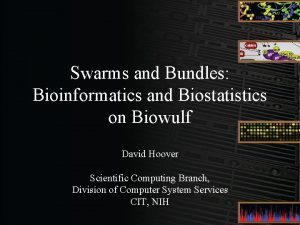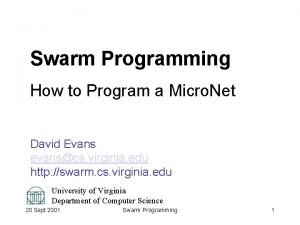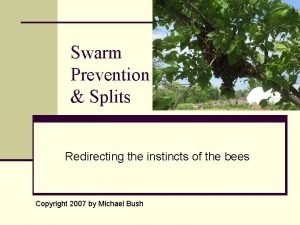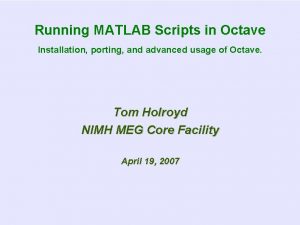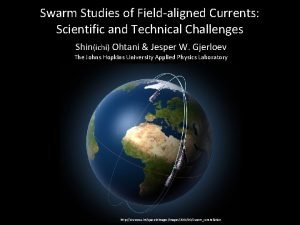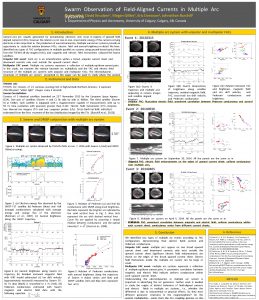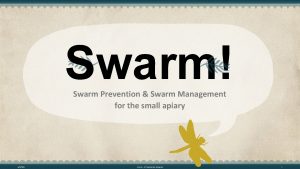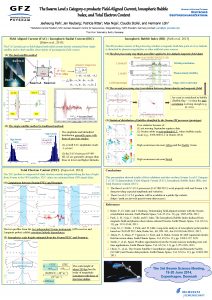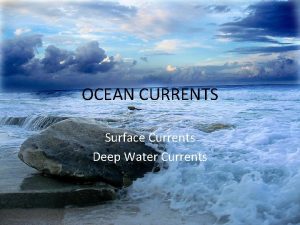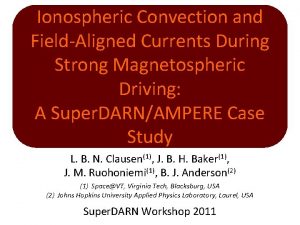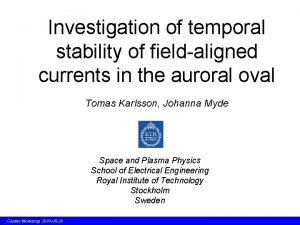Characteristics of fieldaligned currents derived from the Swarm

















- Slides: 17

Characteristics of field-aligned currents derived from the Swarm constellation Hermann Lühr, Jaeheung Park, Jan Rauberg, Ingo Michaelis, Guram Kervalishvili and Claudia Stolle GFZ, German Research Centre for Geosciences Swarm Data Quality Workshop Potsdam, 2 – 5 Dec. 2014 No. 1

Introduction to field-aligned currents Field-aligned currents are an important element in space plasma physics since they can carry energy and momentum lossless over large distances. They are strongest at auroral latitudes and form a distinct local time pattern noon (Iijima and Potemra, 1976) Swarm Data Quality Workshop, Potsdam 2 – 5 Dec. 2014 No. 2

FAC estimates from single satellite Current estimates from magnetic field measurements are commonly based on Ampère's law. For the vertical component one can write From satellite data we only obtain along-track field variations. The equation has to be simplified. where vx is the velocity component in flight direction ΔBy the perpendicular field variations and Δt the time step. Assumptions: (1) The FACs is stationary for the time of passage. (2) FACs are organised in sheets, oriented perpendicular to the flight direction. Swarm Data Quality Workshop, Potsdam 2 – 5 Dec. 2014 No. 3

Example of single satellite FAC estimate Large-scale FACs (>150 km) show the typical morning side pattern. Small-scale FACs (~10 km) have much larger amplitudes but vary significantly in time. They are expected to be carried by kinetic Alfvén waves. Swarm-A and –C are sampled at 7 s time differences. The shift in latitude of Swarm-C indicates an equatorward motion of the FAC structure. Swarm Data Quality Workshop, Potsdam 2 – 5 Dec. 2014 No. 4

Temporal variation of small-sale FACs We consider observations at the same location (orbital cross-over) but at different times. Small and large-scale FACs exhibit different behaviour. Small-scale FACs (<10 km) vary on time scales of the order of 10 s. Large-scale FACs (>150 km) are stable for more than 60 s. South Pole SW-A auroral oval SW-C Swarm Data Quality Workshop, Potsdam 2 – 5 Dec. 2014 No. 5

FAC longitudinal correlation length Measurements at the same magnetic latitude but at different longitudes are considered. For large-scale FACs we find good correlations up to ~10° in longitude separation for most LT sectors. An exception is the dayside, cusp, a region with smaller correlation lengths. SW-B auroral oval SW-A SW-C Swarm Data Quality Workshop, Potsdam 2 – 5 Dec. 2014 No. 6

Résumé for FACs from single satellites From the Swarm constellation observations we can conclude for the auroral oval: v Assumption (1, stationarity) is violated for small-scale FACs; their amplitude is varying rapidly with time. For large-scale FACs the assumption is fulfilled. v Assumption (2, sheet geometry) is fulfilled for large-scale FACs at most local times. Smaller longitudinal correlations length are found predominantly around noon, cusp region. The orientation of the current sheet can be determined by minimum variance analysis and accounted for in the analysis. v Conclusion: FAC estimates from single satellites magnetic field recordings are reliable when the data are filtered at a cutoff period of order 20 s and the sheet orientation is considered. v Small-scale FACs cannot be determined reliably, but their contribution to the energy budget seems to be important for ionosphere-ionosphere coupling. (For more information see our poster at the AGU meeting) Swarm Data Quality Workshop, Potsdam 2 – 5 Dec. 2014 No. 7

Dual-satellite FACs Much more robust FAC estimates can be derived when magnetic field measurements from several satellites are considered. In case of Swarm we take data from the lower pair, Swarm-A/C. The reading of the leading Swarm-C are shifted in time (5 -10 s) such that a real side-by-side sampling is achieved. We use the Level 1 b data from which all non-ionospheric magnetic contributions are removed. Data have been corrected for the VFMASM disturbance (see Michaelis et al. , Wednesday) and are lowpass filtered at a 20 s cutoff period. The applied algorithm for current estimate is Ampère’s integral. Swarm Data Quality Workshop, Potsdam 2 – 5 Dec. 2014 No. 8

Field-aligned currents from the Swarm constellation Using Ampère‘s integral in discrete form 2 dℓ 1 1 Sw. A 3 dℓ 4 4 Sw. C Along-track variations are derived from two subsequent measurements dt=5 sec dl 1, 3=38 km Cross-track separation is 1. 4° in longitude. Swarm Data Quality Workshop, Potsdam 2 – 5 Dec. 2014 No. 9

Field-aligned currents from the Swarm constellation v Dual-FACs from Swarm-A/C are calculated for every second. v At latitudes above 86° no dual-FACs are calculated since the cross-track separation is less than 3 km. v Comparisons between single and dual-FACs are shown for different local times. Swarm Data Quality Workshop, Potsdam 2 – 5 Dec. 2014 No. 10

IMAGE magnetometer Swarm 71. 2° 67. 0° 65. 8° 64. 3° 63. 1° 60. 5° Swarm Data Quality Workshop, Potsdam 2 – 5 Dec. 2014 No. 11

Swarm Data Quality Workshop, Potsdam 2 – 5 Dec. 2014 No. 12

Swarm Data Quality Workshop, Potsdam 2 – 5 Dec. 2014 No. 13

Swarm Data Quality Workshop, Potsdam 2 – 5 Dec. 2014 No. 14

Swarm Data Quality Workshop, Potsdam 2 – 5 Dec. 2014 No. 15

Summary Ø The early Swarm mission phase was useful to test underlying assumptions for FAC determination from single satellite. More details are given by a poster for AGU meeting. Ø Reliable FAC estimates can be achieved from the Swarm-A/C pair after the final orbit constellation has been achieved at middle of April and after correction for ASM/VFM differences. Ø Single and dual-satellite FAC estimates generally match quite well. Differences show up in the polar cap. Ø In the southern hemisphere the auroral overlaps with the geographic pole. In that region dual-satellite FAC estimates are not reliable. Swarm Data Quality Workshop, Potsdam 2 – 5 Dec. 2014 No. 16

Swarm Data Quality Workshop, Potsdam 2 – 5 Dec. 2014 No. 17
 What is deep current
What is deep current Biowulf swarm
Biowulf swarm Swarm theory reading answers
Swarm theory reading answers Swarm programming
Swarm programming Swarm prevention split
Swarm prevention split Newsflash swarm
Newsflash swarm Biowulf swarm
Biowulf swarm Docker swarm
Docker swarm Hình ảnh bộ gõ cơ thể búng tay
Hình ảnh bộ gõ cơ thể búng tay Slidetodoc
Slidetodoc Bổ thể
Bổ thể Tỉ lệ cơ thể trẻ em
Tỉ lệ cơ thể trẻ em Voi kéo gỗ như thế nào
Voi kéo gỗ như thế nào Tư thế worms-breton
Tư thế worms-breton Chúa yêu trần thế
Chúa yêu trần thế Các môn thể thao bắt đầu bằng tiếng chạy
Các môn thể thao bắt đầu bằng tiếng chạy Thế nào là hệ số cao nhất
Thế nào là hệ số cao nhất Các châu lục và đại dương trên thế giới
Các châu lục và đại dương trên thế giới

